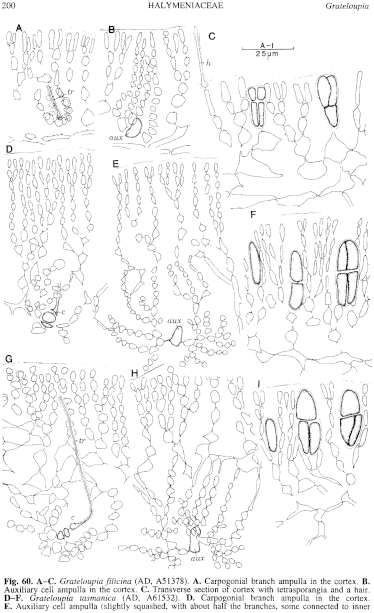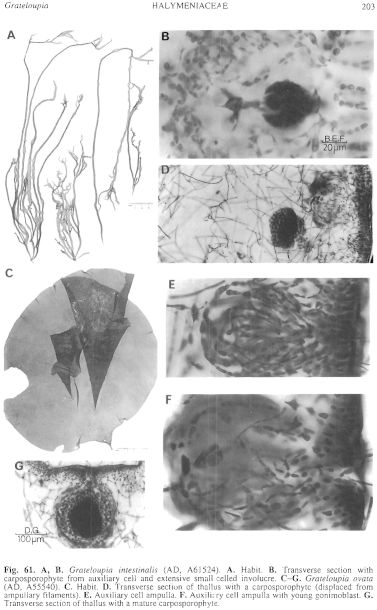|
|
|
|
|
|||||||||||
|
Electronic Flora of South Australia Species Fact Sheet
Phylum Rhodophyta – Class Florideophyceae – Order Gigartinales – Family Halymeniaceae
Selected citations: Kraft 1977c: 43, figs 1–8, 10–21.
Synonym
Nemastoma intestinalis Harvey 1855b: 254.
Thallus (Fig. 61A) medium to dark red-brown, 10–50 cm high, soft and mucilaginous (adhering strongly to paper), the base of older plants often drying cartilaginous, with several long main branches with occasional laterals but often proliferous at any position; lower parts often with short (1–2 cm long) laterals; main branches 3–5 mm broad, slightly compressed. Holdfast discoid, small; epilithic. Structure (Fig. 61B) multiaxial, developing a more or less hollow medulla filled with mucilage, with stellate cells at the periphery, and a cortex 5–9 cells thick, inner cells subspherical, 8–12 µm in diameter, grading to isodiametric outer cells in anticlinal rows, the outermost slightly elongate, 2–4 µm in diameter. Refractive ganglionic cells absent.
Reproduction: Sexual thalli dioecious. Carpogonial branches 2-celled, borne in relatively simple ampullae (Fig. 60G) in the inner cortex. Auxiliary cell ampullae (Fig. 60H) densely branched, cupulate, within the inner cortex or outer medulla. Carposporophyte (Fig. 61B) coming to lie in the hollow medulla, dense, 60–120 µm across, ovoid to conical, with a basal fusion cell and ovoid carposporangia 6–10 µm in diameter; involucre prominent, derived from ampullary filaments by their proliferation, cells ovoid; ostiole absent. Spermatangia cut off from outer cortical cells.
Tetrasporangia (Fig. 60I) on mid cortical cells and lying in the outer cortex, scattered, elongate-ovoid, 20–35 µm long and 10–25 µm in diameter, cruciately divided.
Type from Preservation Harbour, southern N.Z. (Lyall); in BM.
Selected specimens: Swansea, Tas., mid-low intertidal (Kraft, 15.xii.1992; MELU, A40456). Taroona, Hobart, Tas., in low eulittoral pools (Womersley, 13.i.1949; AD, A10142) and low eulittoral (Sanderson, 24.xi.1991; AD, A61533). South Arm, Hobart, Tas., on littoral rock (Levring, 24.i.1948; AD, A61274). Kingston, Tas., lower eulittoral (Sanderson, 24.xi.1991; AD, A61524).
Distribution: Throughout New Zealand. SE Tasmania.
Taxonomic notes: The original publication of this name according to Chapman & Parkinson (1974, p.246) is by Hooker & Harvey (1845, p. 521), but the "Algae Novae Zelandiae" paper of Hooker & Harvey does not mention this species, which was described as new by Harvey in 1855b.
Kraft (1977c) has described the structure and reproduction of G. intestinalis and pointed out that in the densely branched auxiliary cell ampullae and the well-developed involucre derived from continued branching of the ampullary filaments, this species is atypical of Grateloupia. However, the habit and vegetative structure ally it with Grateloupia and it seems best to leave it in this genus.
The Australian plants, known only from SE Tasmania, agree well with those from New Zealand.
References:
CHAPMAN, V.J. & PARKINSON, P.G. (1974). The marine algae of New Zealand. Part DI: Rhodophyceae. Issue 3: Cryptonemiales. (Cramer: Germany.)
HARVEY, W.H. (1855b). Algae. In Hooker, J.D., The Botany of the Antarctic Voyage. II. Flora Novae-Zelandiae. Part II, pp. 211–266, Plates 107–121.
HOOKER, J.D. & HARVEY, W.H. (1845). Algae Novae Zelandiae. Lond. J. Bot. 4, 521–551.
KRAFT, G.T. (1977c). The morphology of Grateloupia intestinalis from New Zealand, with some thoughts on generic criteria within the family Cryptonemiaceae (Rhodophyta). Phycologia 16, 43–51.
The Marine Benthic Flora of Southern Australia Part IIIA complete list of references.
Publication:
Womersley, H.B.S. (14 January, 1994)
The Marine Benthic Flora of Southern Australia
Rhodophyta. Part IIIA, Bangiophyceae and Florideophyceae (to Gigartinales)
Reproduced with permission from The Marine Benthic Flora of Southern Australia Part IIIA 1994, by H.B.S. Womersley. Australian Biological Resources Study, Canberra. Copyright Commonwealth of Australia.
Illustrations in Womersley Part IIIA, 1994: FIGS 60 G–I, 61A, B.

Figure 60 enlarge
Fig. 60. A–C. Grateloupia filicina (AD, A51378). A. Carpogonial branch ampulla in the cortex. B. Auxiliary cell ampulla in the cortex. C. Transverse section of cortex with tetrasporangia and a hair. D–F. Grateloupia tasmanica (AD, A61532). D. Carpogonial branch ampulla in the cortex. E. Auxiliary cell ampulla (slightly squashed, with about half the branches, some connected to inner cortical cells). F. Transverse section of cortex with tetrasporangia. G–I. Grateloupia intestinalis (AD, A61524). G. Carpogonial branch ampulla in the cortex. H. Auxiliary cell ampulla, with filaments connected to inner cortical cells. I. Transverse section of cortex with tetrasporangia.

Figure 61 enlarge
Fig. 61. A, B. Grateloupia intestinalis (AD, A61524). A. Habit. B. Transverse section with carposporophyte from auxiliary cell and extensive small-celled involucre. C–G. Grateloupia ovata (AD, A55540). C. Habit. D. Transverse section of thallus with a carposporophyte (displaced from ampullary filaments). E. Auxiliary cell ampulla. F. Auxiliary cell ampulla with young gonimoblast. G. Transverse section of thallus with a mature carposporophyte.

|
Email Contact: State Herbarium of South Australia |

|